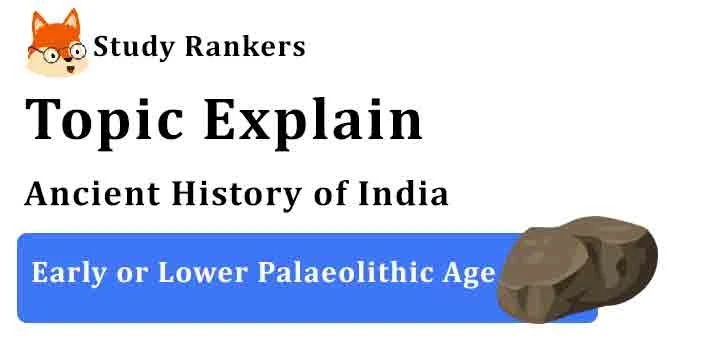Early or Lower Palaeolithic Age - Ancient History of India
In this article, we will learn about the Early or Lower Palaeolithic Age which is a part of Ancient History of India and very important for UPSC, SSC, NET and other competitive exams. We will see tools, sites and lifestyle of lower Palaeolithic Age that will be useful in performing better in the exams. It will provide strengths to every aspirant's preparation and always getting better each day.

During the Lower Palaeolithic cultural phase, human ancestor species of Homo erectus is believed to have lived in India. This period covers the greater part of Ice Age. The early or lower Palaeolithic period is dated around two million years ago and upto 60,000 years ago.
Read about Palaeolithic Age.
Early or Lower Palaeolithic Tools
The Lower Palaeolithic is characterized by hand axes, cleavers, chopping tools, and related artefact forms. The tools were all made by removing flakes from a block or core of stone until it reached the required size and shape. They used the tools for hunting, butchering and skinning the animals, breaking the bones for bone marrow and to recover tubers and plant foods, and for processing food.
• Handaxe: It is generally a core tool which is roughly triangular in shape, broad at one end and pointed at the other.
• Cleaver: This has a biface edge and is more or less transversal. It was used for clearing and splitting objects such as trunks of trees.
• Chopper: A massive core tool in which the working edge is prepared by unifacial flanking and used for chopping purposes.
• Chopping Tool: It is again a massive core tool like Chopper but the working edge is bifacially prepared by alternate flanking. Used for similar purpose as the chopper, it was more effective due to its edge being sharper.
Early or Lower Palaeolithic Sites
The sites of the Early Palaeolithic period have been found in the Sohan valley (in West Punjub, which is presently in Pakistan), the Narmada valley (in Madhya Pradesh, Maharashtra and Gujarat), Didwana (in Rajasthan), Bhimbetka (near Bhopal in Madhya Pradesh), Kashmir and Thar Desert.
The industries of Palaeolithic cultures are divided into the Early, Middle and Late Acheulian Industries. The early Acheulian tools include polyhedrons, spheroids, hand axes, cleavers and flake tools. The Acheulian tradition is absent in the Western Ghats, coastal areas and north-eastern India. The Acheulian artefacts were made principally on hard and durable quartzites.
• Based on research, two independent cultural traditions of hand axe (Acheulian) and pebble-flake (Sohanian) industries were confirmed in India. Acheulian industry mainly had hand axes and cleavers while the Sohan industry is considered to have used only chopper and chopping tools.
In the Hunsgi valley of Karnataka, limestone was used; at Lalitpur in Central India, pink granite was chosen while in parts of Maharashtra and Central India basalt was preferred. Belan valley in Uttar Pradesh, desert area of Didwana in Rajasthan, Chirki- Nevasa in Maharashtra, Nagarjunakonda in Andhra Pradesh are some of the important sites which have yielded Lower Palaeolithic tools.
The caves and rock shelters of Bhimbetka near Bhopal also show features of the Lower Palaeolithic age.
The rivers Palar, Penniyar and Kaveri in Tamil Nadu are rich in Palaeolithic tools. Attiranmpakkam and Gudiyam (in Tamilnadu) have yielded both Early and Middle Palaeolithic artefacts like handaxes, flakes, blades, scrapers etc.
Early or Lower Palaeolithic Lifestyle
The people of Lower Palaeolithic culture hunted animals and gathered roots, nuts and fruits. They fed on the flesh and bones of animals killed by predators. They lived in open air, river valleys, caves and rock shelters.






0 Comments
Comment Related Post
Emoji